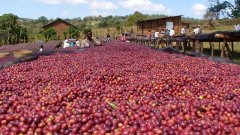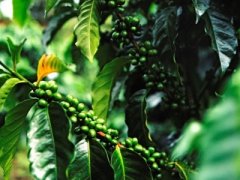Introduction to baking instructions for the flavor and taste of boutique coffee at Mchana Estate Mechana Manor in Kenya
Kenya Mchana Estate (Mechana Manor) AA Top
Mchana Manor, located in the Ruiru district of Thika province, north of NAIROBI, Kenya, began growing coffee in 1950.

As Britain / France / West / Portugal / Netherlands and other countries were maritime powers in the 18th century, all regions such as Africa / Central and South America / South Asia were subject to their invasion and seizure of resources and looting. For example, Britain's notorious "East India Company" business project is not only opium, but also profitable industries are controlled by them. Therefore, in the colonial era before the independence of African countries, in addition to the coffee industry controlled by the East India Company, France was also associated with Africa.

The French company Socfinal also entered Kenya in the 1950s with the agricultural advantage of a big country and controlled a large number of coffee producing areas and production interests. In its heyday, Socfinal had nine estates and more than 10, 000 coffee growers. Later, Socfinal reorganized its new company name "KOFINAF". At present, it still owns the following nine coffee farms
Mchana
Tatu
Ruera
Okalands
Karangaita
Gethumbwini (Gozvini Manor is also a well-known high-priced bean)
Eaagads
Mtaro
Karogo
Mchana Manor is located in the mountains above 1700 meters above sea level, with an average annual temperature of 15-26 ℃. With typical Kenyan fertile volcanic laterite with good water conservation capacity, the region has abundant rainfall, with two rainy season peaks between March and June and October to December. In the rest of the season, workers use pre-stored Rain Water to carry out artificial irrigation to prevent coffee trees from drying up too much.

At present, there are different opinions on the varieties of beans exported by Mchana. It has been confirmed that there are two kinds of beans exported from Kenya, SL28 and SL34, while others will mention the varieties of K7 and Ruiru11, but the company's website does not specifically specify it, so it is not so sure. Mchana means "afternoon" in the local term, but it may be due to the translation of nouns. Mochana or Muchana are also used. Beans in the manor are harvested from October to December every year, and the scaffolding after washing before picking is treated by scaffolding. The size of raw beans is about 17 to 18 mesh, with UTZ (Good inside) good coffee certification and RAF (rainforest protection certification), with an annual output of about 17000 packets (30kg).
The characteristic of baked beans is that when baked in SCAA (1 explosion + 20sec. 212 ℃)
~ the sour taste of the fruit is bright, and the entrance is as smooth as drinking citrus or plum-like fruit tea, and then the aroma permeates the whole mouth and throat.
Those who are afraid of sour taste or do not like sour taste are advised to choose SCAA shallow medium baking section close to the beginning of secondary baking or medium baking at the beginning of secondary baking (216,218 ℃), almost no sour taste with chocolate and caramel flavor.
Important Notice :
前街咖啡 FrontStreet Coffee has moved to new addredd:
FrontStreet Coffee Address: 315,Donghua East Road,GuangZhou
Tel:020 38364473
- Prev

Introduction to the taste of yellow bourbon treated with honey from Camo Minas Gaojing Manor in Brazil
Yellow bourbon honey treatment! Production Information: country: Brazil / Brazil: Camominas producer: Gao King Manor altitude: 1060-1290 m Variety: Yellow Bourbon / Yellow bourbon treatment: honey treatment baking degree: medium baking flavor: orange, apricot flavor, soft and sweet acidity, extremely rich taste, middle and back section with hazelnut, chocolate and maple syrup sweet taste
- Next

Kenya Tekangu Cooperative High-quality Coffee introduces the Sustainable Management of Coffee
The Tegu treatment plant, which belongs to the Tekangu cooperative, is a very successful processing plant in Nyeri, where 900 small farmers pick and select red cherries by hand and send them to the processing plant. Raw beans are divided into three grades, and the first two grades are processed and fermented respectively. Local small farmers send the picked cherries to excellent processing plants, which in turn get more compensation, and about 90% of them will be given back to farmers. In recent years, the processing plant
Related
- Does Rose Summer choose Blue, Green or Red? Detailed explanation of Rose Summer Coffee plots and Classification in Panamanian Jade Manor
- What is the difference between the origin, producing area, processing plant, cooperative and manor of coffee beans?
- How fine does the espresso powder fit? how to grind the espresso?
- Sca coffee roasting degree color card coffee roasting degree 8 roasting color values what do you mean?
- The practice of lattes: how to make lattes at home
- Introduction to Indonesian Fine Coffee beans-- Java Coffee producing area of Indonesian Arabica Coffee
- How much will the flavor of light and medium roasted rose summer be expressed? What baking level is rose summer suitable for?
- Introduction to the characteristics of washing, sun-drying or wet-planing coffee commonly used in Mantenin, Indonesia
- Price characteristics of Arabica Coffee Bean Starbucks introduction to Manning Coffee Bean Taste producing area Variety Manor
- What is the authentic Yega flavor? What are the flavor characteristics of the really excellent Yejasuffi coffee beans?

